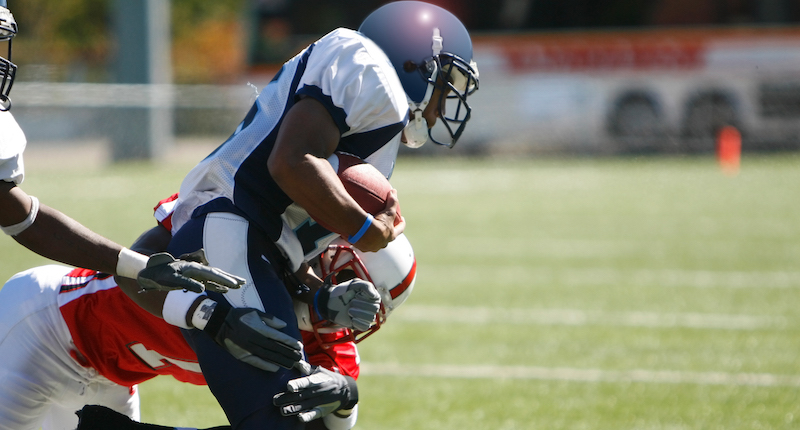
Scholars argue that OSHA could make the “workplace” for professional football players safer.
Football players risk their lives in the name of entertainment. With recent research showing the life-altering impacts of game-related concussions, should the federal government step in to regulate the sport?
According to a recent article, the answer is “yes.” The Occupational Safety and Health Administration (OSHA) should issue rules to make football safer, say the article’s authors.
Although OSHA has never asserted authority over National Football League (NFL) teams, the authors conclude that NFL “workplaces” could be regulated because football players satisfy the criteria specified in the common-law test of an employee.
The article’s authors are Adam M. Finkel of the University of Michigan School of Public Health, lawyer Chris Deubert, Orly Lobel of the University of San Diego School of Law, Glenn Cohen of Harvard Law School, and Holly Fernandez Lynch at the University of Pennsylvania Perelman School of Medicine.
Finkel and his coauthors argue that because OSHA has jurisdiction over other private-sector employees, the federal workplace safety regulator would by extension also have jurisdiction over NFL players as employees.
The common-law test for defining who qualifies as an employee, as articulated by the U.S. Supreme Court, relies on several factors to establish workers’ status: the extent of the employer’s control over the employee; the nature of the work performed; and the treatment of employee benefits and taxation. These factors generally weigh in favor of defining players as employees. For example, NFL clubs pay player salaries, impose fines for prohibited behavior, decide players’ work schedules, and provide facilities and necessary equipment.
According to the Occupational Safety and Health Act of 1970, OSHA can regulate industries through two routes: It can regulate through the “general duty clause,” and it can set standards for workplace safety and health. The general duty clause requires an employer to “furnish to each of his employees employment and a place of employment which are free from recognized hazards that are causing or are likely to cause death or serious physical harm to his employees.” Finkel and his coauthors suggest that OSHA could demonstrate that the hazards linked to playing professional football can cause serious physical harm, violating the general duty clause.
But OSHA must do more than just establish demonstrable hazards to regulate a workplace. It also must specify a feasible means of eliminating or materially reducing those hazards.
Legal precedent from the entertainment industry may favor OSHA exercising authority over the NFL too. Finkel and his coauthors point to SeaWorld of Florida v. Perez, in which an administrative law judge within OSHA, as well the U.S. Court of Appeals for the D.C. Circuit, found that SeaWorld had violated the general duty clause following the death of an animal trainer by a killer whale. SeaWorld argued that OSHA’s means of eliminating the hazards “changed the nature of its business so fundamentally that it could not be considered a feasible means of eliminating or reducing the hazard.” The administrative judge and the court disagreed with SeaWorld.
SeaWorld also argued that the trainers had accepted the risks associated with the job when they signed waivers. But the court rejected this argument, placing “the duty to ensure a safe and healthy workplace on the employer not the employee.” Applying the SeaWorld court’s reasoning about employer duty to the NFL would mean that the league has a duty to take precaution against injury, conclude Finkel and his coauthors.
In a dissenting opinion for SeaWorld, then-Judge Brett Kavanaugh addressed sports in particular, declaring them to be especially risky and emphasizing that “some risk cannot be eliminated without fundamentally altering the nature of the activity as defined within the industry.”
Finkel and his coauthors challenge Kavanaugh’s argument, though, instead suggesting that experts, both inside and outside the sport, determine whether a proposed change would excessively transform the game. For example, experts might show that although prohibiting tackling entirely might exceed OSHA’s authority, a ban on particular methods of tackling could be within the realm of OSHA’s general duty clause authority.
Alternatively, OSHA could regulate the NFL under its “standard setting” authority by showing both that there is a “significant risk of material impairment of health to employees” and that a federal standard is both economically and technologically feasible as a means to eliminate or reduce the harm.
To support a showing of significant risk, Finkel and his coauthors note that there was an average of 160 regular-season concussions between 2009 and 2016. They cite two studies that have shown that NFL players suffer from higher rates of neurological disease than the general public. In fact, in a study of 111 NFL players, 110 were found to have a degenerative disease that scientists believe to be caused by head-on collision.
Finkel and his coauthors also assert that a hypothetical OSHA standard would also be feasible both technologically and economically, given the NFL’s yearly revenues.
So, why might OSHA be reluctant to regulate the NFL? For one, Finkel and his coauthors speculate that OSHA might have higher priorities than regulating a sport involving only 2,000 to 3,000 employees, especially ones who are sufficiently compensated and represented by a union.
Finkel and his coauthors also speculate that OSHA’s reluctance to act stems from a lack of expertise on sports matters, especially on the technical issues involved with head injuries and psychological disorders.
Despite the potential reasons for OSHA’s reluctance to regulate the NFL, Finkel and his coauthors offer several ways in which OSHA could engage in cooperative efforts with the NFL to promote safety. For one, the NFL could request that OSHA review its policies and protocols. Working together, the NFL and OSHA could also create an “enforceable partnership,” giving OSHA a legal basis for citing general duty clause violations when necessary. Through an enforceable partnership, OSHA could address players’ concerns uniformly, revise agreements promptly, and prevent lengthy and unfavorable public hearings.
Ultimately, Finkel and his coauthors conclude that although there is limited precedent for OSHA to regulate the NFL and professional sports generally, it should consider taking action to protect NFL players from unhealthy working conditions.



